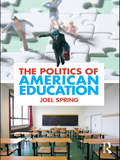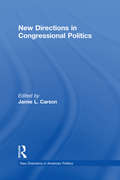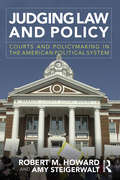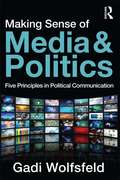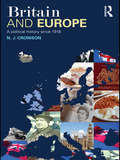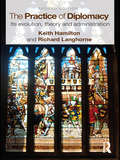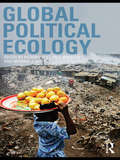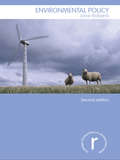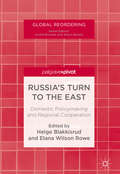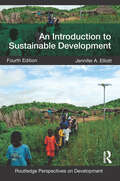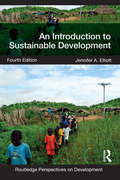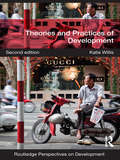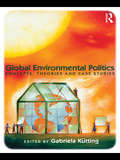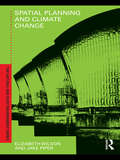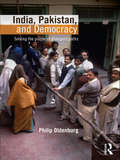- Table View
- List View
The Politics of American Education
by Joel SpringTurning his distinctive analytical lens to the politics of American education, Joel Spring looks at contemporary educational policy issues from theoretical, practical, and historical perspectives. This comprehensive overview documents and explains who influences educational policy and how, bringing to life the realities of schooling in the 21st century and revealing the ongoing ideological struggles at play. Coverage includes the influence of global organizations on American school policies and the impact of emerging open source and other forms of electronic textbooks. Thought-provoking, lucid, original in its conceptual framework and rich with engaging examples from the real world, this text is timely and useful for understanding the big picture and the micro-level intricacies of the multiple forces at work in controlling U.S. public schools . It is the text of choice for any course that covers or addresses the politics of American education. Companion Website: The interactive Companion Website accompanying this text includes relevant data, public domain documents, YouTube links, and links to websites representing political organizations and interest groups involved in education.
New Directions in Congressional Politics
by Jamie L. CarsonAs the U.S. Congress has steadily evolved, so too has our understanding of the institution. New Directions in Congressional Politics offers an accessible overview of the current developments in our understanding of America’s legislative branch. Jamie L. Carson helps students bridge the gap between roles, rules, and outcomes by focusing on four themes woven throughout: the importance of electoral considerations, legislators’ strategic behavior to accomplish objectives, the unique challenges of Congress as a bicameral institution, and the often-overlooked policy outputs of the institution. This book brings together leading scholars of Congress to provide a general overview of the entire field. Each chapter covers the cutting edge developments on its respective topic. As the political institution responsible for enacting laws, the American public regularly looks to the U.S. Congress to address the important issues of the day. The contributors in this volume help explain why staying atop the research trends help us better understand these issues.
New Directions in Congressional Politics
by Jamie L. CarsonAs the U.S. Congress has steadily evolved, so too has our understanding of the institution. New Directions in Congressional Politics offers an accessible overview of the current developments in our understanding of America’s legislative branch. Jamie L. Carson helps students bridge the gap between roles, rules, and outcomes by focusing on four themes woven throughout: the importance of electoral considerations, legislators’ strategic behavior to accomplish objectives, the unique challenges of Congress as a bicameral institution, and the often-overlooked policy outputs of the institution. This book brings together leading scholars of Congress to provide a general overview of the entire field. Each chapter covers the cutting edge developments on its respective topic. As the political institution responsible for enacting laws, the American public regularly looks to the U.S. Congress to address the important issues of the day. The contributors in this volume help explain why staying atop the research trends help us better understand these issues.
Judging Law and Policy: Courts and Policymaking in the American Political System
by Amy Steigerwalt Robert M. HowardTo what extent do courts make social and public policy and influence policy change? This innovative text analyzes this question generally and in seven distinct policy areas that play out in both federal and state courts—tax policy, environmental policy, reproductive rights, sex equality, affirmative action, school finance, and same-sex marriage. The authors address these issues through the twin lenses of how state and federal courts must and do interact with the other branches of government and whether judicial policy-making is a form of activist judging. Each chapter uncovers the policymaking aspects of judicial process by investigating the current state of the law, the extent of court involvement in policy change, the responses of other governmental entities and outside actors, and the factors which influenced the degree of implementation and impact of the relevant court decisions. Throughout the book, Howard and Steigerwalt examine and analyze the literature on judicial policy-making as well as evaluate existing measures of judicial ideology, judicial activism, court and legal policy formation, policy change and policy impact. This unique text offers new insights and areas to research in this important field of American politics.
Making Sense of Media and Politics: Five Principles in Political Communication
by Gadi WolfsfeldPolitics is above all a contest, and the news media are the central arena for viewing that competition. One of the central concerns of political communication has to do with the myriad ways in which politics has an impact on the news media and the equally diverse ways in which the media influences politics. Both of these aspects in turn weigh heavily on the effects such political communication has on mass citizens. In Making Sense of Media and Politics, Gadi Wolfsfeld introduces readers to the most important concepts that serve as a framework for examining the interrelationship of media and politics: political power can usually be translated into power over the news media when authorities lose control over the political environment they also lose control over the news there is no such thing as objective journalism (nor can there be) the media are dedicated more than anything else to telling a good story the most important effects of the news media on citizens tend to be unintentional and unnoticed. By identifying these five key principles of political communication, the author examines those who package and send political messages, those who transform political messages into news, and the effect all this has on citizens. The result is a brief, engaging guide to help make sense of the wider world of media and politics and an essential companion to more in-depths studies of the field.
Making Sense of Media and Politics: Five Principles in Political Communication
by Gadi WolfsfeldPolitics is above all a contest, and the news media are the central arena for viewing that competition. One of the central concerns of political communication has to do with the myriad ways in which politics has an impact on the news media and the equally diverse ways in which the media influences politics. Both of these aspects in turn weigh heavily on the effects such political communication has on mass citizens. In Making Sense of Media and Politics, Gadi Wolfsfeld introduces readers to the most important concepts that serve as a framework for examining the interrelationship of media and politics: political power can usually be translated into power over the news media when authorities lose control over the political environment they also lose control over the news there is no such thing as objective journalism (nor can there be) the media are dedicated more than anything else to telling a good story the most important effects of the news media on citizens tend to be unintentional and unnoticed. By identifying these five key principles of political communication, the author examines those who package and send political messages, those who transform political messages into news, and the effect all this has on citizens. The result is a brief, engaging guide to help make sense of the wider world of media and politics and an essential companion to more in-depths studies of the field.
Britain and Europe: A Political History Since 1918
by N. J. CrowsonThis textbook provides a comprehensive account of Britain’s uneasy relationship with continental Europe from 1918 to the present day. Unlike other books on the subject, the author considers 'Europe' in its broadest sense and examines a wider history than just Britain's relations with the European Union (EU). This includes pre-war history and the role of key political institutions outside the EU such as the Council of Europe and the Western European Union. Subjects covered include: how the experience of the inter-war years and the Second World War helped shape attitudes towards the EU european perspectives on Britain as well as the other way round key theories on European integration the changing nature of Britain's global role issues of sovereignty and legitimacy the role of political parties and the Europeanisation of national government the rise of Euroscepticism in British politics and how ‘Europe’ has become entwined in the ideological battles of the main political parties. Exploring the political, diplomatic and military relationship between Britain and Europe, this accessible and wide-ranging textbook is essential core reading for students of British and European history and politics.
Britain and Europe: A Political History Since 1918
by N. J. CrowsonThis textbook provides a comprehensive account of Britain’s uneasy relationship with continental Europe from 1918 to the present day. Unlike other books on the subject, the author considers 'Europe' in its broadest sense and examines a wider history than just Britain's relations with the European Union (EU). This includes pre-war history and the role of key political institutions outside the EU such as the Council of Europe and the Western European Union. Subjects covered include: how the experience of the inter-war years and the Second World War helped shape attitudes towards the EU european perspectives on Britain as well as the other way round key theories on European integration the changing nature of Britain's global role issues of sovereignty and legitimacy the role of political parties and the Europeanisation of national government the rise of Euroscepticism in British politics and how ‘Europe’ has become entwined in the ideological battles of the main political parties. Exploring the political, diplomatic and military relationship between Britain and Europe, this accessible and wide-ranging textbook is essential core reading for students of British and European history and politics.
The Practice of Diplomacy: Its Evolution, Theory and Administration
by Keith Hamilton Professor Richard LanghornePractice of Diplomacy has become established as a classic text in the study of diplomacy. This much-needed second edition is completely reworked and updated throughout and builds on the strengths of the original text with a strong empirical and historical focus. Topics new and updated for this edition include: discussion of Ancient and non-European diplomacy including a more thorough treatment of pre-Hellenic and Muslim diplomacy and the diplomatic methods prevalent in the inter-state system of the Indian sub-continent evaluation of human rights diplomacy from the nineteenth-century campaign against the slave trade onwards a fully updated and revised account of the inter-war years and the diplomacy of the Cold War, drawing on the latest scholarship in the field an entirely new chapter discussing core issues such as climate change; NGOs and coalitions of NGOs; trans-national corporations; foreign ministries and IGOs; the revolution in electronic communications; public diplomacy; transformational diplomacy and faith-based diplomacy. This text has established itself as a core text in the field of diplomacy and this new edition is absolutely essential reading for students and practitioners of diplomacy.
The Practice of Diplomacy: Its Evolution, Theory and Administration
by Keith Hamilton Professor Richard LanghornePractice of Diplomacy has become established as a classic text in the study of diplomacy. This much-needed second edition is completely reworked and updated throughout and builds on the strengths of the original text with a strong empirical and historical focus. Topics new and updated for this edition include: discussion of Ancient and non-European diplomacy including a more thorough treatment of pre-Hellenic and Muslim diplomacy and the diplomatic methods prevalent in the inter-state system of the Indian sub-continent evaluation of human rights diplomacy from the nineteenth-century campaign against the slave trade onwards a fully updated and revised account of the inter-war years and the diplomacy of the Cold War, drawing on the latest scholarship in the field an entirely new chapter discussing core issues such as climate change; NGOs and coalitions of NGOs; trans-national corporations; foreign ministries and IGOs; the revolution in electronic communications; public diplomacy; transformational diplomacy and faith-based diplomacy. This text has established itself as a core text in the field of diplomacy and this new edition is absolutely essential reading for students and practitioners of diplomacy.
Global Political Ecology
by Richard Peet Paul Robbins Michael WattsThe world is caught in the mesh of a series of environmental crises. So far attempts at resolving the deep basis of these have been superficial and disorganized. Global Political Ecology links the political economy of global capitalism with the political ecology of a series of environmental disasters and failed attempts at environmental policies. This critical volume draws together contributions from twenty-five leading intellectuals in the field. It begins with an introductory chapter that introduces the readers to political ecology and summarizes the books main findings. The following seven sections cover topics on the political ecology of war and the disaster state; fuelling capitalism: energy scarcity and abundance; global governance of health, bodies, and genomics; the contradictions of global food; capital’s marginal product: effluents, waste, and garbage; water as a commodity, a human right, and power; the functions and dysfunctions of the global green economy; political ecology of the global climate, and carbon emissions. This book contains accounts of the main currents of thought in each area that bring the topics completely up-to-date. The individual chapters contain a theoretical introduction linking in with the main themes of political ecology, as well as empirical information and case material. Global Political Ecology serves as a valuable reference for students interested in political ecology, environmental justice, and geography.
Global Political Ecology
by Richard Peet Paul Robbins Michael WattsThe world is caught in the mesh of a series of environmental crises. So far attempts at resolving the deep basis of these have been superficial and disorganized. Global Political Ecology links the political economy of global capitalism with the political ecology of a series of environmental disasters and failed attempts at environmental policies. This critical volume draws together contributions from twenty-five leading intellectuals in the field. It begins with an introductory chapter that introduces the readers to political ecology and summarizes the books main findings. The following seven sections cover topics on the political ecology of war and the disaster state; fuelling capitalism: energy scarcity and abundance; global governance of health, bodies, and genomics; the contradictions of global food; capital’s marginal product: effluents, waste, and garbage; water as a commodity, a human right, and power; the functions and dysfunctions of the global green economy; political ecology of the global climate, and carbon emissions. This book contains accounts of the main currents of thought in each area that bring the topics completely up-to-date. The individual chapters contain a theoretical introduction linking in with the main themes of political ecology, as well as empirical information and case material. Global Political Ecology serves as a valuable reference for students interested in political ecology, environmental justice, and geography.
Environmental Policy
by Jane RobertsEvidence of climate change, resource shortages and biodiversity loss is growing in significance year by year. This second edition of Environmental Policy explains how policy can respond and bring about greater sustainability in individual lifestyles, corporate strategies, national policies and international relations. The book discusses the interaction between environmental and human systems, proposing environmental policy as a way to steer human systems to function within environmental constraints. The second edition has been completely updated to reflect advances in scholarship (for example developments in governance theory) and the increasing primacy of climate policy within environmental policy as a whole. Key political, social and economic concepts are used to explain how effective environmental policies can be designed, implemented and evaluated. Environmental problems, the role of human beings in creating them and sustainable development are all introduced. Environmental policy formulation, implementation and evaluation are discussed within three specific contexts: the firm, the nation state and at an international level. The book reviews the relationship of economics, science and technology to environmental policy. It ends by reflecting upon the predicament of humankind in the twenty-first century and the potential of achieve sustainability through the use of the environmental policy ‘toolbox’. Environmental Policy is an accessible text with a multi-disciplinary perspective. Lively case studies drawn from a range of international examples – and completely updated for this second edition – illustrate issues such as climate change, international trade, tourism and human rights. It includes chapter summaries, suggestions for further reading and links to relevant web resources.
Environmental Policy
by Jane RobertsEvidence of climate change, resource shortages and biodiversity loss is growing in significance year by year. This second edition of Environmental Policy explains how policy can respond and bring about greater sustainability in individual lifestyles, corporate strategies, national policies and international relations. The book discusses the interaction between environmental and human systems, proposing environmental policy as a way to steer human systems to function within environmental constraints. The second edition has been completely updated to reflect advances in scholarship (for example developments in governance theory) and the increasing primacy of climate policy within environmental policy as a whole. Key political, social and economic concepts are used to explain how effective environmental policies can be designed, implemented and evaluated. Environmental problems, the role of human beings in creating them and sustainable development are all introduced. Environmental policy formulation, implementation and evaluation are discussed within three specific contexts: the firm, the nation state and at an international level. The book reviews the relationship of economics, science and technology to environmental policy. It ends by reflecting upon the predicament of humankind in the twenty-first century and the potential of achieve sustainability through the use of the environmental policy ‘toolbox’. Environmental Policy is an accessible text with a multi-disciplinary perspective. Lively case studies drawn from a range of international examples – and completely updated for this second edition – illustrate issues such as climate change, international trade, tourism and human rights. It includes chapter summaries, suggestions for further reading and links to relevant web resources.
Russia's Turn to the East: Domestic Policymaking and Regional Cooperation
by Helge Blakkisrud Elana Wilson RoweThis book is open access under a CC BY license.This book explores if and how Russian policies towards the Far East region of the country – and East Asia more broadly – have changed since the onset of the Ukraine crisis and Russia’s annexation of Crimea. Following the 2014 annexation and the subsequent enactment of a sanctions regime against the country, the Kremlin has emphasized the eastern vector in its external relations. But to what extent has Russia’s 'pivot to the East' intensified or changed in nature – domestically and internationally – since the onset of the current crisis in relations with the West? Rather than taking the declared 'pivot' as a fact and exploring the consequences of it, the contributors to this volume explore whether a pivot has indeed happened or if what we see today is the continuation of longer-duration trends, concerns and ambitions.
Russia's Turn to the East: Domestic Policymaking and Regional Cooperation
by Helge Blakkisrud Elana Wilson RoweThis book is open access under a CC BY license.This book explores if and how Russian policies towards the Far East region of the country – and East Asia more broadly – have changed since the onset of the Ukraine crisis and Russia’s annexation of Crimea. Following the 2014 annexation and the subsequent enactment of a sanctions regime against the country, the Kremlin has emphasized the eastern vector in its external relations. But to what extent has Russia’s 'pivot to the East' intensified or changed in nature – domestically and internationally – since the onset of the current crisis in relations with the West? Rather than taking the declared 'pivot' as a fact and exploring the consequences of it, the contributors to this volume explore whether a pivot has indeed happened or if what we see today is the continuation of longer-duration trends, concerns and ambitions.
An Introduction to Sustainable Development
by Jennifer ElliottThis fourth edition has been comprehensively rewritten and updated to provide a concise, well illustrated and accessible introduction to the characteristics, challenges and opportunities of sustainable development with particular reference to developing countries. The contested nature of sustainable development is explored through a detailed consideration of changing ideas and practices within environmentalism and development thinking. The text identifies the different actors involved (from institutions of global governance through to community based organisations), the policies and mechanisms through which sustainable development is being sought and considers the outcomes for particular groups and environments in both rural and urban contexts. ?? This edition places stronger emphasis on the global challenges of sustainable development with an understanding of inter-linked crises in climate, energy, economy, poverty and social injustice. It explores how these issues are leading to deep questioning of what sustainable development is, what it should be, and how sustainable development policies and mechanisms are being reconsidered. The book gives new consideration to the challenge of achieving lower carbon growth, climate adaptation, and the implications on sustainable development of rapidly expanding economies, including China and India. It contains greater discussion of how civil society movements influence outcomes of international climate policy, as well as technological developments in energy and agriculture. The text also contains a substantially expanded discussion of how poverty remains central to sustainable development challenges, as revealed through the Millennium Ecosystem Assessment and Millennium Development Goals. This invaluable text retains the core message that sustainable development has become central to debates about environment and development. Containing a substantial number of new boxed case studies, learning outcomes, chapter summaries, discussion questions, further reading and websites, this text provides an essential introduction for students.
An Introduction to Sustainable Development
by Jennifer ElliottThis fourth edition has been comprehensively rewritten and updated to provide a concise, well illustrated and accessible introduction to the characteristics, challenges and opportunities of sustainable development with particular reference to developing countries. The contested nature of sustainable development is explored through a detailed consideration of changing ideas and practices within environmentalism and development thinking. The text identifies the different actors involved (from institutions of global governance through to community based organisations), the policies and mechanisms through which sustainable development is being sought and considers the outcomes for particular groups and environments in both rural and urban contexts. ?? This edition places stronger emphasis on the global challenges of sustainable development with an understanding of inter-linked crises in climate, energy, economy, poverty and social injustice. It explores how these issues are leading to deep questioning of what sustainable development is, what it should be, and how sustainable development policies and mechanisms are being reconsidered. The book gives new consideration to the challenge of achieving lower carbon growth, climate adaptation, and the implications on sustainable development of rapidly expanding economies, including China and India. It contains greater discussion of how civil society movements influence outcomes of international climate policy, as well as technological developments in energy and agriculture. The text also contains a substantially expanded discussion of how poverty remains central to sustainable development challenges, as revealed through the Millennium Ecosystem Assessment and Millennium Development Goals. This invaluable text retains the core message that sustainable development has become central to debates about environment and development. Containing a substantial number of new boxed case studies, learning outcomes, chapter summaries, discussion questions, further reading and websites, this text provides an essential introduction for students.
Theories and Practices of Development
by Katie WillisGlobal economic crisis and the implications of global environmental change have led academics and policy-makers to consider how ‘development’ in all parts of the world should be achieved. However, ‘development’ has always been a contested idea. While often presented as a positive process to improve people’s lives, the potential negative dimensions of ‘development’ on people and environments must also be recognized. Theories and Practices of Development provides a clear and user-friendly introduction to the complex debates around how development has been understood and achieved. The second edition has been fully updated and expanded to reflect global political and economic shifts, as well as new approaches to development. The rise of China and India is given particular attention, as is the global economic crisis and its implications for development theories and practice. There are new sections on faith-based development, and the development dimensions of climate change, as well as greater engagement with development theories as they are put into practice in the Global North. The book deals with the evolution of development ideas and policies, focusing on economic, political, social, environmental and spatial dimensions. It highlights how development cannot be considered as a neutral concept, but is entwined with inequalities in power at local, as well as national and global scales. The use of boxed examples, tables and illustrations helps students understand complex theoretical ideas and also demonstrates how development theories are put into practice in the real world. Each chapter ends with a summary section, discussion topics, suggestions for further reading and website resources.
Global Environmental Politics: Concepts, Theories and Case Studies
by Gabriela KüttingGlobal Environmental Politics is the perfect introduction to this increasingly significant area. The text combines an accessible introduction to the most important environmental theories and concepts with a series of detailed case studies of the most pressing environmental problems. Features and benefits of the book: Explains the most important concepts and theories in environmental politics. Introduces environmental politics within the context of political science and international relations theories. Demonstrates how the concepts and theories apply in a wide variety of real world contexts. Case studies include the most important environmental issues from climate change and biodiversity to forests and marine pollution. Each chapter is written by an established international authority in the field. ? This exciting new textbook is essential reading all students of environmental politics and will be of great interest to students of International Relations and Political Economy.
Global Environmental Politics: Concepts, Theories and Case Studies
by Gabriela KüttingGlobal Environmental Politics is the perfect introduction to this increasingly significant area. The text combines an accessible introduction to the most important environmental theories and concepts with a series of detailed case studies of the most pressing environmental problems. Features and benefits of the book: Explains the most important concepts and theories in environmental politics. Introduces environmental politics within the context of political science and international relations theories. Demonstrates how the concepts and theories apply in a wide variety of real world contexts. Case studies include the most important environmental issues from climate change and biodiversity to forests and marine pollution. Each chapter is written by an established international authority in the field. ? This exciting new textbook is essential reading all students of environmental politics and will be of great interest to students of International Relations and Political Economy.
Spatial Planning and Climate Change
by Elizabeth Wilson Jake PiperSpatial planning has a vital role to play in the move to a low carbon energy future and in adapting to climate change. To do this, spatial planning must develop and implement new approaches. Elizabeth Wilson and Jake Piper explore a wide range of issues in this comprehensive book on the relationship between our changing climate and spatial planning, and suggest ways of addressing the challenges by taking a longer-sighted approach to our preparation for the future. This text includes: an overview of what we know already about future climate change and its impacts, as we attempt both to adapt to these changes and to reduce the emissions which cause them the role of spatial planning in relation to climate change, offering some theoretical and political explanations for the challenges that planning faces in the coming decades a review of policy and legislation at international, EU and UK levels in regard to climate change, and the support this gives to the planning system case studies detailing what responses the UK and the Netherlands have made so far in light of the evidence ways to help new and existing urban developments to reduce energy use and to adapt to climate change, through strengthening the relationships between urban and rural areas to avoid water shortage, floods or loss of biodiversity. The authors take an evidence-based look at this hugely important topic, providing a well-illustrated text for spatial planning professionals, politicians and the interested public, as well as a useful reference for postgraduate planning, geography, urban studies, urban design and environmental studies students.
Spatial Planning and Climate Change
by Elizabeth Wilson Jake PiperSpatial planning has a vital role to play in the move to a low carbon energy future and in adapting to climate change. To do this, spatial planning must develop and implement new approaches. Elizabeth Wilson and Jake Piper explore a wide range of issues in this comprehensive book on the relationship between our changing climate and spatial planning, and suggest ways of addressing the challenges by taking a longer-sighted approach to our preparation for the future. This text includes: an overview of what we know already about future climate change and its impacts, as we attempt both to adapt to these changes and to reduce the emissions which cause them the role of spatial planning in relation to climate change, offering some theoretical and political explanations for the challenges that planning faces in the coming decades a review of policy and legislation at international, EU and UK levels in regard to climate change, and the support this gives to the planning system case studies detailing what responses the UK and the Netherlands have made so far in light of the evidence ways to help new and existing urban developments to reduce energy use and to adapt to climate change, through strengthening the relationships between urban and rural areas to avoid water shortage, floods or loss of biodiversity. The authors take an evidence-based look at this hugely important topic, providing a well-illustrated text for spatial planning professionals, politicians and the interested public, as well as a useful reference for postgraduate planning, geography, urban studies, urban design and environmental studies students.
India, Pakistan, and Democracy: Solving the Puzzle of Divergent Paths
by Philip OldenburgThe question of why some countries have democratic regimes and others do not is a significant issue in comparative politics. This book looks at India and Pakistan, two countries with clearly contrasting political regime histories, and presents an argument on why India is a democracy and Pakistan is not. Focusing on the specificities and the nuances of each state system, the author examines in detail the balance of authority and power between popular or elected politicians and the state apparatus through substantial historical analysis. India and Pakistan are both large, multi-religious and multi-lingual countries sharing a geographic and historical space that in 1947, when they became independent from British rule, gave them a virtually indistinguishable level of both extreme poverty and inequality. All of those factors militate against democracy, according to most theories, and in Pakistan democracy did indeed fail very quickly after Independence. It has only been restored as a façade for military-bureaucratic rule for brief periods since then. In comparison, after almost thirty years of democracy, India had a brush with authoritarian rule, in the 1975-76 Emergency, and some analysts were perversely reassured that the India exception had been erased. But instead, after a momentous election in 1977, democracy has become stronger over the last thirty years. Providing a comparative analysis of the political systems of India and Pakistan as well as a historical overview of the two countries, this textbook constitutes essential reading for students of South Asian History and Politics. It is a useful and balanced introduction to the politics of India and Pakistan.
India, Pakistan, and Democracy: Solving the Puzzle of Divergent Paths
by Philip OldenburgThe question of why some countries have democratic regimes and others do not is a significant issue in comparative politics. This book looks at India and Pakistan, two countries with clearly contrasting political regime histories, and presents an argument on why India is a democracy and Pakistan is not. Focusing on the specificities and the nuances of each state system, the author examines in detail the balance of authority and power between popular or elected politicians and the state apparatus through substantial historical analysis. India and Pakistan are both large, multi-religious and multi-lingual countries sharing a geographic and historical space that in 1947, when they became independent from British rule, gave them a virtually indistinguishable level of both extreme poverty and inequality. All of those factors militate against democracy, according to most theories, and in Pakistan democracy did indeed fail very quickly after Independence. It has only been restored as a façade for military-bureaucratic rule for brief periods since then. In comparison, after almost thirty years of democracy, India had a brush with authoritarian rule, in the 1975-76 Emergency, and some analysts were perversely reassured that the India exception had been erased. But instead, after a momentous election in 1977, democracy has become stronger over the last thirty years. Providing a comparative analysis of the political systems of India and Pakistan as well as a historical overview of the two countries, this textbook constitutes essential reading for students of South Asian History and Politics. It is a useful and balanced introduction to the politics of India and Pakistan.
